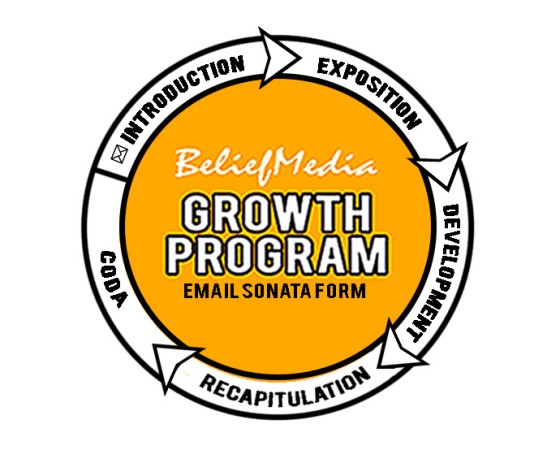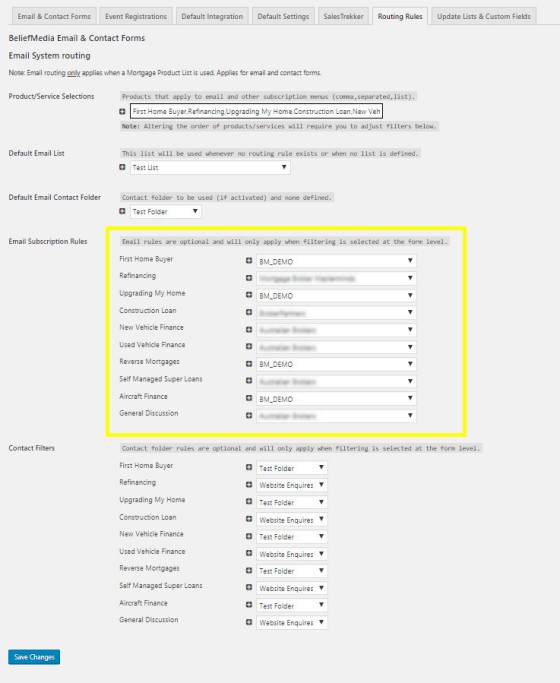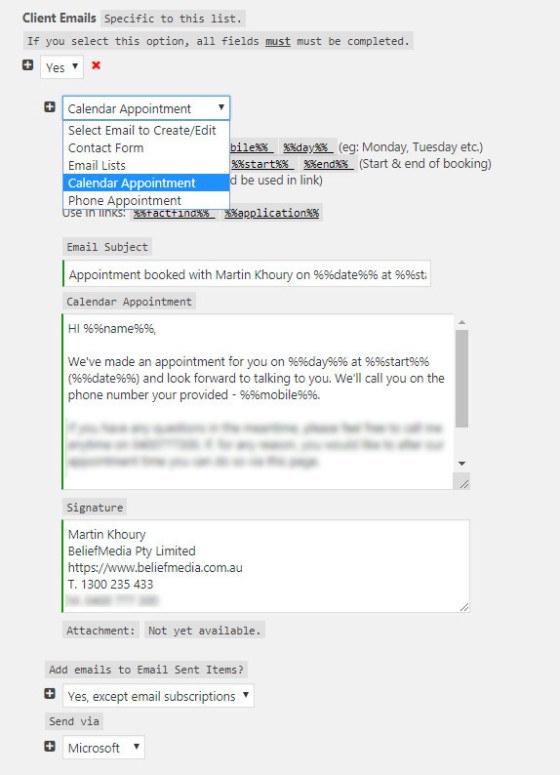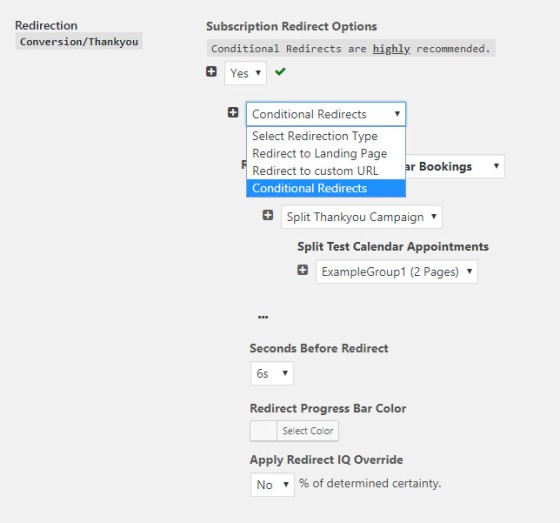If a website call-to-action isn't suitably crafted and a user doesn't succumb to the charms of our primary conversion goal (in the service industry this is usually a phone call), it's important to convert visitors in other ways - most notably a social media follow or, preferably, an email subscription. This action on the subscriber's part plugs them into a funnel experience and provides the education, incentive, or reasons for doing business with you that you couldn't necessary provide via your website experience. This article looks at BeliefMedia's high-performing Symphony Email Framework in brief, and how the steps of our framework determines the frequency and type of email content sent during the course of an online courtship.
The email subscription can take place in any number of ways, although it is normally triggered via the download of an opt-in relationship offer (or "lead magnet"). The relationship offer is provided to provide part-way pain relief for your visitor; it seeks to take them closer to finding a solution for the problem for which they're seeking answers. The ultimate goal of the magnet is to provide enough information of value that your visitor might trust you enough to make contact. The email sequence that ensues will invariably build upon that relationship and add a measure of assurance to your services and/or product.
We've found that the majority of the lead magnets floating around cyberspace are rubbish - particularly in the finance market where we tend to attract a large client base (we're sick of seeing generic two-and-a-half page reports that don't offer any kind of special insight). Your lead magnet is an opportunity to set yourself apart; fail to deliver upon expectations or the 'hype' that encourages the download and you'll completely alienate your audience. We've scheduled an article detailing our approach to lead magnets here.
It might be argued that the lead magnet is slowly losing its effectiveness. The abundance of garbage downloads has created an environment where web audiences are slowly developing a broad mistrust of lead magnets the same way we've slowly blinded ourselves to banner advertising. However, this slow and arguably inevitable eventuality opens up opportunities to develop other more meaningful ways of attracting business. That said, current lead magnets effectiveness does mean that it'll maintain a place in online marketing in one form or another for as long as the Internet exists.
Every Page Is A Conversion Opportunity
If you subscribe to our material you'll be familiar with a few lines we tend to repeat over and over - one of them is that every single page on your website is a conversion opportunity. While free-from-distraction and purpose-built landing pages do convert far higher than most other pages on your website, that's no reason to ignore conversion opportunities on every page (every page of your website is a potential entry page... and therefore a "landing page"). Additionally, your purpose-built landing pages should never be hosted outside your website. In fact, your entire marketing experience - from landing pages, email subscriptions, calendar widgets, and everything in between - should almost always be self-hosted under your trusted (and secure) domain. We've drafted an article titled "It's Time To Stop Feeding The Finance Marketing Sharks" where we talk about the fragmented, totally incomplete, and unscalable marketing foundations some of our "competitors" seem to advocate.
So, if every page on your website is a potential entry page, and every page is a quasi-landing page, then the email conversion (usually by way of a relationship offer) should be visible on every page of your website. At the very least, email popups and splash pages should be very strategically managed so they're delivered to the appropriate audience at the most relevant time, and only used when genuinely required. If you've ever invested time, effort, or finances into Search Engine Optimisation without maximising conversion opportunities for organic traffic, you're simply not going to see results that are commensurate with your investment. Having an SEO program in place without an accompanying conversion on-page strategy is simply a waste of time.
Tip: If you're looking to build a basic landing page inside of your WordPress website, we have an article scheduled here that'll detail a crude way in which to format a 'naked' WP page.
Subscribing to a relationship offer is a means of having your visitor dip their toes into the top of your marketing funnel. Further engagement by way of your email program (and social etc.) serves multiple agendas - one of which is to edge a prospect further into your sales experience and establish you as a business of choice.
Isn't The Email Sequence Just Spam?
If all you're doing with your emails is selling or engaging in ridiculous self-promotion you'll lose me. Use click-bait style headlines, try fancy-pants headlines that over-promise, overuse casing, or share poor quality content, and it's an open invitation to hit the unsubscribe button. That all said, if your emails provide high-level content, contain real value, and are curated specifically for your segmented audience, they are absolutely not spam. Curated correctly, your emails will be seen as a resource that are relied upon by your subscribers.
We'll be publishing another here that looks at how to create emails with unrivaled open and interaction rates.
The Symphony Sequence
Once referred to internally as the "Marty Method", our Symphony Sequence email framework is designed to emulate the natural flow of a symphony. In brief, each movement of a symphony is written differently, tells a new story, and comes back to themes that tend to define the score. With the optional introduction and conclusion (if there is one) the entire sequence is generally four movements - each representing a particular component of a purchase journey (or passage of time). The entire framework is built to provide information from anywhere between thirty-five days to eighteen months (although in most markets the typical process lasts around three months).
A typical symphony typically consists of four movements as follows:
- Opening Sonata or Allegro.
- Slow movement, such as Adagio.
- Minuet or Scherzo with Trio.
- Allegro, Rondo, or Sonata.
The first and most important wave of emails are sent shortly after subscription and follow what we refer to internally as the Sonata form. These complete, but not independent sections, are detailed below.
- Introduction.
- Exposition.
- Development.
- Recapitulation.
- Coda.
The Sonata form generally includes those emails sent during the early stages of a relationship when a buyer is hyperactive (or in the 'buy now' phase).
Pictured: The Sonata Format (part of the opening Sonata or Allegro sequence).
The First Movement (Sonata)
Introduction
The introduction to your email program is just that - an introduction. The first email is sent in response to the subscription and generally provides nothing more than a download link. It can obviously include more if the market requires it. The second email - the proper introduction - comes very shortly after the first and introduces your business, brand, and culture, and it sets the expectation for additional emails you have scheduled. The introductory email (which normally has a very high open rate) should come from the General Manager, CEO, or the company evangelist, and it must define very clearly the objective of your contact - you want to hear from them.
If you're using multiple funnels and email sequences (which is the norm) you will normally qualify your subscriber and potentially filter them into a more appropriate email experience. This is usually accomplished via a simple question with a few links that will unsubscribe the user from one list and add them to another. The subscriber should always experience the journey that is most applicable to their purchase. In the finance market, for example, there's no point sending a series of emails on Investment Loans or Self-Manager Super if they're a young first home buyer.
Exposition
A lead magnet download often comes from a red-hot "Buy Now" market in hunt mode. Your subscriber is actively looking for the solutions that you can provide, and this hunt-mode usually lasts between six and ten days. If we lose our subscriber over this period it may be that we'll lose that early sale.
So, the exposition seeks to provide emails that will detail your services in a way that leans towards education and value... and far from being salesy. Demonstrate your value and your subscriber will be compelled to call you. We include emails that detail product features and comparisons, frequency asked questions, videos, podcasts, additional downloads, and general educational content.
We'll generally send an email every day for the first six to ten days (depending upon the market) and then throttle right back (without compromising on quality of content) as we ease the sequence into the Development movement.
Development
From Wikipedia, "the Development starts in the same key as the exposition ended, and may move through many different keys during its course. It will usually consist of one or more themes from the exposition altered and on occasion juxtaposed and may include new material or themes. Alterations include taking material through distant keys, breaking down of themes and sequencing of motifs, and so forth." It's an apt description of how our Development works. We start in the same tone as our Exposition before introducing new content that relates directly to the older content we've previously provided, but we'll break down the themes introduced in the first sequence down into smaller chunks of information.
Our market may still be a hot prospect so we generally send Development emails three to five days apart for around two weeks. We'll always provide shorter emails with high quality content (such as webinars or other giveaways) in this sequence.
Recapitulation
The recapitulation normally starts in the third week. At this stage we would have established if the prospect is interested in working or buying from us or not (via those that have unsubscribed or interacted positively in other ways). At this point we'll normally restate the themes from the exposition, provide additional referrals, write about real-world examples, and so on. The underlying premise is that we'll want to summarize the entire exposition and parts of the development in just two or three emails.
The Coda
The Coda is used to restore the sequence to the 'home key' after an off-tonic recapitulation. We return to roots and ask the question we would have asked before yet again: how can we help you? This isn't your last opportunity to make contact but it is the termination of our rapid-fire Sonata model.
The Second, Third, and Fourth Movements
The termination of the Sonata also marks the introduction of the 'slow' movement. Email is sent far less frequently (maybe once per month)... although the pace does pick up again leading into the third movement - still slow but a little more playful with specific information that may have become relevant. In the finance world, for example, towards the twelve or eighteen month mark our long-forgotten subscriber might be looking at refinancing (assuming they made a purchase around the time they originally subscribed). If this is the case our emails would be curated to introduce the benefits of such - perhaps with specific examples, testimonials, and so on.
Our fourth movement is a little more fast-paced and reintroduces the subscriber to who we are, what we're doing, and our point of difference. This is particularly relevant in the finance world, for example, because if former representation didn't provide adequate custom care of post settlement support, they'll be introduced to your expertise all over again at a time when it may be most appropriate.
When Does The Sequence End?
It doesn't. Over a period of time you should build upon an email sequence that provides relevant information over any number of years. The Sonata sequence is the only movement that doesn't repeat itself (until they're introduced to our business as a customer). The second, third, and fourth movements repeat themselves on a loop with new content. These irregular emails supplement any formal newsletters and other emails you may have in place.
How Often Is Too Often?
We want to send email often enough that we're top of mind yet infrequent enough that we don't upset anybody. Remember, our early rapid sequence of emails is only sent during a time when they're our subscriber is most receptive to the information we share with them.
Don't be perturbed by subscribers leaving your list; it's natures way of self-cleaning.
Segmented Audiences
Introduction
As our email list matures the subscribers might develop into a new audience. So, we should routinely provide options to identify if a subscriber 'qualifies' for a new list via triggers (usually attached to external links) that are designed to filter a user into a more appropriate group. We'll generally provide our own clients with the option of unsubscribing an individual from one list and moving them to another, or simply adding them to a new list in addition to the one that they're enjoying.
Email List Segmentation
Our email system will subscribe a user to a list which is most relevant. On cold pages we'll usually provide a select menu with the typical "What Can We Help You With?" text. On landing pages we may make certain assumptions and subscribe them to a defined list. Either way, the process of initial segmentation will explode the effectiveness of any associated email campaign. We filter each service type you have defined into a particular email list (shown below).
Pictured: Defining email segmentation rules in the BM plugin. Note that we also segment each contact into an appropriate Outlook contact folder (adding a contact to Outlook is usually applied to clients that make a booking).
The First Sonata Email
It's not uncommon to subscribe different users to the same list from different landing pages. We refine the relevance of communication by delivering the "First Email" as defined for each type of contact. The email is curated based upon page interaction (basic subscriber, phone contact, or calendar booking).
Pictured: Creating a form-level first email. It delivers relevance.
There's no more significant means of retaining email subscribers and generating conversions than by ensuring recipients are always on the receiving content that is most relevant to them. Another article is scheduled here that details the extremely important "First Email" in the Sonata sequence.
While outside the scope of this article it's worth noting that our whole funnel experience is highly segmented. For example, as pictured below, we deliver the second (and perhaps third) landing page based on segmenting the audience into appropriate interest groups. More details will be published here.
Pictured: Making a funnel relevant by delivering relevance to the second page conversion. Read more here.
Post Sale Emails
Once a sale is made, the email sequence changes shape and has a focus on product care, post-sales support, and anything else that may now be relevant. The sequence still follows the Symphony sequence since most of the support is required early on, and the value of continued hand-holding becomes less relevant as time moves forward.
Conclusion
Our framework works extremely well if structured correctly, and yields returns unmatched anywhere in the industry. This bold claim is comfortably made after having worked on refining our model over the better part of 20 years, inheriting work completed by others, and after having sent countless millions of emails.
If you're building your first email program the most important step is to map out exactly what you want to achieve, and what specific information or education you should share. It's important to have a well-defined framework with a very specific outcome-based strategy; sending an email sequence without appropriate consideration will seriously diminish its effectiveness. Above all else, remember that you're an educator first and foremost; selling is easy when you're the best at what you do.












